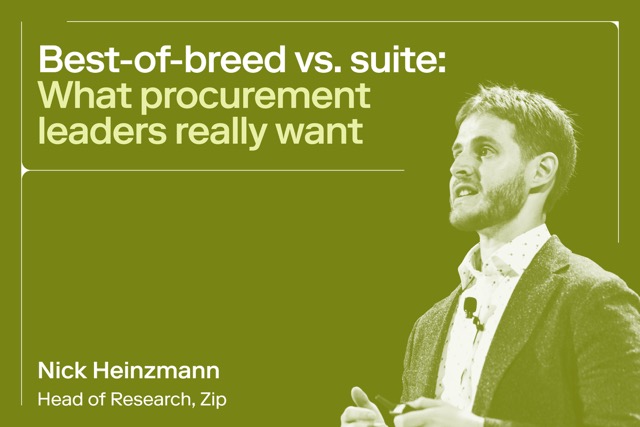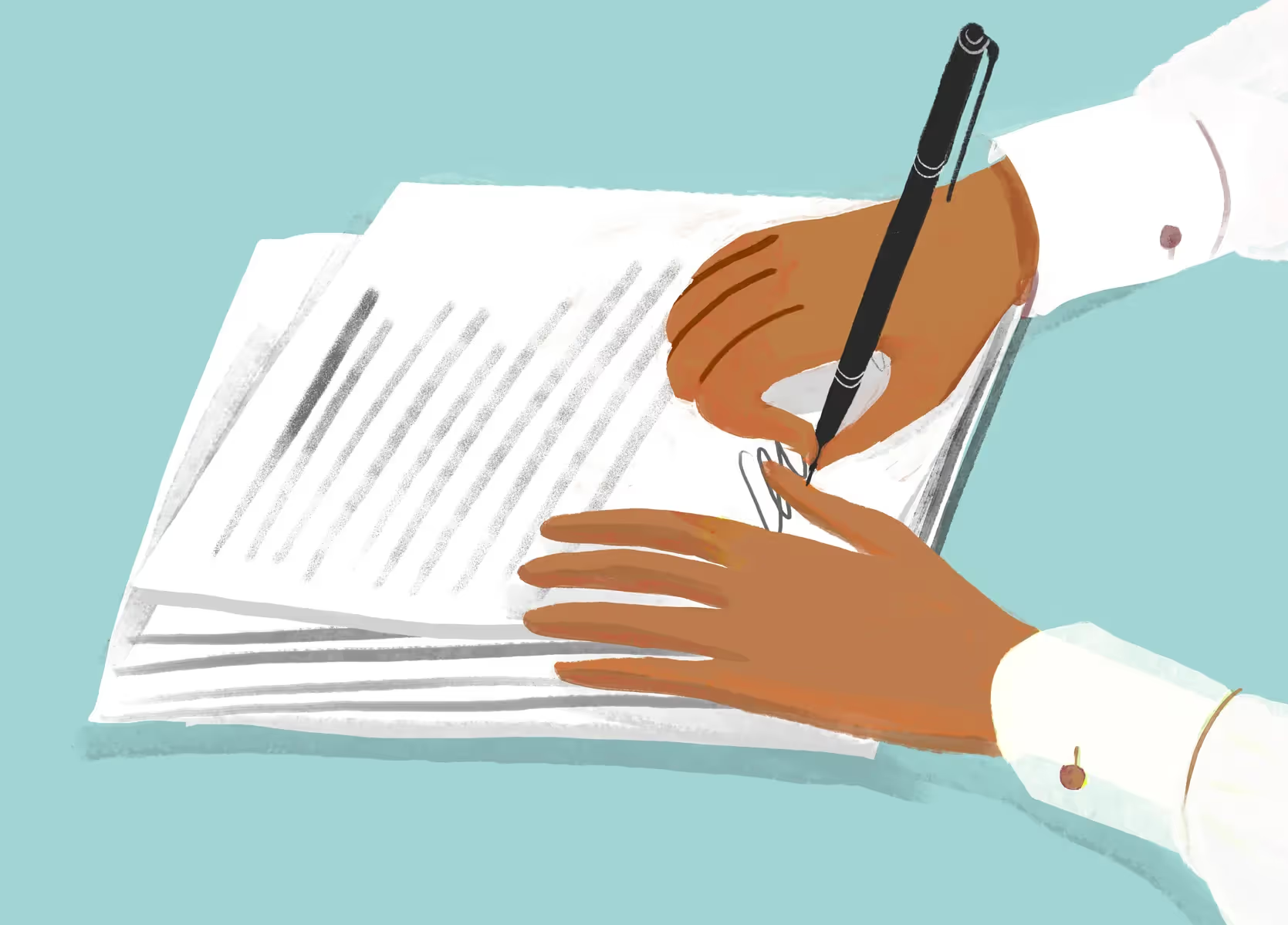
Sourcing vs. Procurement: What's the difference?
Find out how sourcing identifies and selects the best suppliers in procurement.

‘Sourcing’ and ‘Procurement’ are terms often used interchangeably but—as any procurement professional will tell you—they are entirely different processes.
‘Sourcing’ is a single, but crucial part of the procurement cycle, as it determines how and from where your teams actually acquire the goods and services they need to grow business. Procurement is, well, so much more.
If you’re considering building a separate sourcing workstream for your procurement workflow, this article is for you.
Here, we’ll take a look at exactly what ‘sourcing’ and ‘procurement’ are, how they differ, and how they build upon and work together to optimize your company’s purchasing processes. We’ll also look at how Zip, a powerful intake-to-pay platform, can help you streamline your sourcing and procurement activities all in one place.
What is Procurement?
Procurement is the full process of selecting and acquiring the goods and services that your business needs to operate. This involves planning, budgeting, ordering, receiving, paying, and managing the suppliers. Procurement can be divided into two primary stages: sourcing and purchasing.
During the sourcing part of the process, you’ll be finding, evaluating, and selecting the best suppliers for your needs. This requires researching the market, setting your sourcing strategy, soliciting bids, negotiating contracts, and integrating suppliers into your system—all important steps before you buy anything!
Purchasing is when you’re actually placing the orders—paying for and receiving goods and services from suppliers. The focus here is making sure payments are processed on time, goods and services are delivered up to specifications, so ultimately employees are satisfied.
What is Sourcing?
Sourcing, quite simply, is the process of finding the best suppliers for your needs. It is a strategic activity that aims to reduce costs, improve quality, and increase efficiency in your procurement process. Sourcing can be done in different ways, depending on your goals and requirements.
‘General Sourcing’ is the term used for finding suppliers that meet your basic needs, whether that be based on price, quality, or delivery time. This is suitable for low-value or low-risk purchases that don’t require much customization or creative input on your part—just get the stuff!
Another way is to do it is through strategic sourcing, which means finding suppliers that can offer you more value by way of more personalized innovation, collaboration, or sustainability. This is suitable for high-value or high-risk purchase —the kind that may require some degree of customization or white-glove treatment.
What you need to know is that sourcing and purchasing are two parts of the procurement process.
Sourcing vs Purchasing: Key Differences
The sourcing motion and the purchasing process have different goals, focuses, timeframes, process components, and functions. Here’s a handy reference table that summarizes the key differences between sourcing and purchasing:
Understanding the Sourcing Process
Sourcing consists of several steps, all of which help you find the best suppliers for your needs. While the specific steps may vary depending on your sourcing strategy, you’ll almost always need to go through the following process:
- Identify the Need
Before making any moves, you must be very clear about what you need to buy and why.
Start putting pen to paper—define the scope, specifications, and objectives of your purchase, as well as the budget, timeline, and stakeholders involved. You should also assess the current state of your supply chain and identify any gaps or opportunities for improvement.
- Market Research
Take a step back and research the market and find potential suppliers that can meet your needs. Gather information about the suppliers’ capabilities, prices, quality, reputation, and availability. Then take a look at the market trends, risks, and opportunities that may affect your purchase.
- Setting your Sourcing Strategy
Then it’s time to set your sourcing strategy—the plan of how you will find and select the best suppliers for your needs. You should decide whether you want to do general sourcing or strategic sourcing, and whether you want to use a single supplier or multiple suppliers.
Using Zip’s new sourcing tool, much of this process is automated—Zip AI automatically imports content from spreadsheets or docs, suggests potential questions based on the category, and suggests similar vendors to include.
- Solicit Bids through RFPs/RFQs
It’s bidding time! Reach out and solicit bids from the potential suppliers that matched your defined strategy.
Create and send out requests for proposals (RFPs) or requests for quotations (RFQs) that describe your needs, requirements, and expectations, then sit back and enjoy a moment of zen before the bids start rolling in.
- Bid Review and Negotiation
Once you’ve received and compiled bids from suppliers, it’s time to review and evaluate. Compare the bids based on your most important needs and criteria, and rank the suppliers according to their performance.
This is the perfect time to negotiate with the suppliers to get the best deal possible, requesting things like lower prices, better terms, or more value-added services.
- Supplier Selection and Integration
The moment of truth: time to select the best supplier or suppliers for your needs and finalize the contract with them.
You should also integrate the supplier into your system for future procurement needs. Once onboarded, Zip automatically generates renewal workflows and triggers reminders well in advance of renewal deadlines, so you never miss a purchase.
- Set KPIs and begin benchmarking
Finally, be sure to set key performance indicators (KPIs) and begin benchmarking the supplier’s performance. You should measure and monitor the supplier’s performance based on the KPIs, such as quality, delivery, cost, and service.
For more details, check out our ‘Procurement Metrics 101’ guide for the most impactful metrics and KPIs businesses can use to evaluate and optimize procurement processes!
How to Improve the Sourcing Process and Streamline Procurement
We’ve gone over how vital the sourcing process is within the procurement cycle, as it’s the key workflow to determine the best places to acquire goods and services for your business.
Now let’s look at how to improve and streamline the sourcing process to achieve better results. Here are the keys to unlocking a better procurement flow.
Identify and prioritize key requirements
Without prioritizing what you need to buy and why, you’re missing out on an opportunity to rank the factors that influence your decision-making—this will significantly help you make smarter moves. Align your procurement requirements with your business goals and objectives, ensuring that they are realistic and achievable.
Zip’s procurement software platform enables you to create a single front door for all requests, ensuring early involvement of sourcing in the procurement process, thus aligning sourcing activities with your organization's strategic objectives
Conduct thorough supplier research
Preparation is key—gather as much information as possible to help with vetting the potential suppliers that can meet your needs, and verify their credibility and reliability.
You should also compare and contrast suppliers based on your criteria and methods, and narrow down your options to the most suitable ones. Zip's sourcing solution provides full visibility into the process from RFx to contract in a single platform, enabling stakeholders to make informed decisions based on comprehensive data.
Implement a standardized scoring process
Use a consistent and transparent process to evaluate and compare the suppliers, and avoid any bias or subjectivity. Ideally, use objective and measurable criteria and methods to rank the suppliers according to their performance.
Zip’s autonomous sourcing leverages AI automation and templates to streamline the RFx process, allowing for a more efficient evaluation of potential suppliers.
In fact, the new AI-powered scoring experience within Zip Sourcing is so user-friendly and intuitive that cross-functional teams outside procurement are able to efficiently evaluate and score vendors without any training. Yes, it’s that good.
Learn more about how ZipAI can accelerate your workflows today.
Establish strong supplier relationships
Establishing strong supplier relationships will compound value for your teams. Treat suppliers as partners and not as adversaries—communicate and collaborate regularly and share your feedback and expectations. If you can foster trust and mutual respect, you’ll consistently find yourselves with win-win solutions.
Continuously monitor and improve
Finally, you should continuously monitor and improve the supplier’s performance. Measure and track the performance based on your ideal KPIs and benchmark against the industry standards or best practices.
Zip’s new Sourcing dashboards can show you total spend, cycle time insights, and quantified savings. Use this savings center to set and track goals and measure your team’s impact.
Source More and Save More with Zip
To improve your sourcing and procurement process, you’ll need a tool that can help you coordinate, automate, and optimize key workstreams. That’s where Zip comes in.
Zip is a powerful solution that can help you streamline your sourcing process. In fact, Zip offers a comprehensive suite that covers the entire procurement cycle, starting with intake.
If you’re looking to source more and save more, learn more about the brand new Sourcing tool from Zip.
Happy sourcing!

Maximize the ROI of your business spend

Enter your business email to keep reading



























.webp)



















.avif)













.avif)










.webp)





.avif)












.avif)
